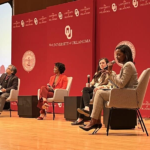Rural and small town ideas from the OU Placemaking Conference IQC 2023
Recently I attended the OU (University of Oklahoma) Institute for Quality Communities (IQC) Placemaking Conference This was the 10th annual event. There were 600 people attending from 40 counties in Oklahoma and 6 surrounding states. I attended the 2017 event along with my colleague Deb Brown. The focus was inevitably on big cities, but I […]
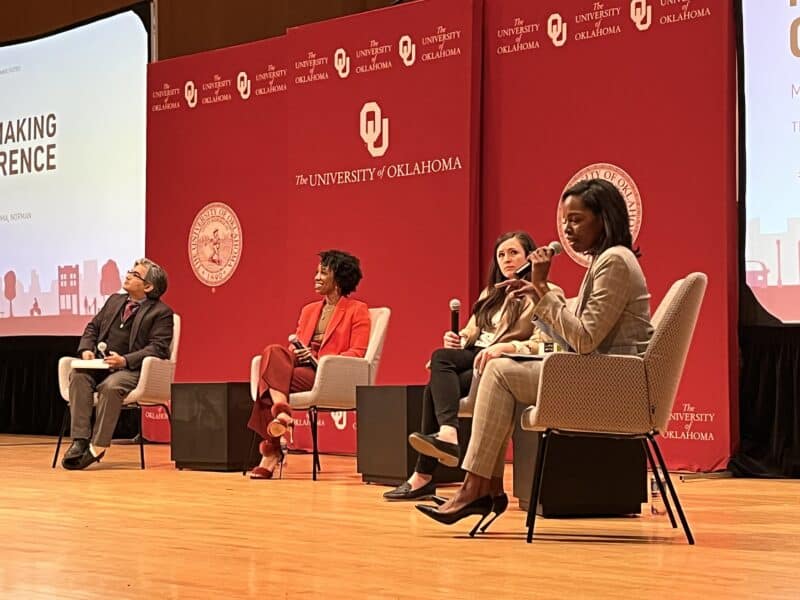
Vanessa Morrison (holding mic) moderates a panel of the ecosystem of communities with (left to right) Mukul Malhorta, Kia Weatherspoon, and Allison Quinlan.
Recently I attended the OU (University of Oklahoma) Institute for Quality Communities (IQC) Placemaking Conference
This was the 10th annual event. There were 600 people attending from 40 counties in Oklahoma and 6 surrounding states.
I attended the 2017 event along with my colleague Deb Brown. The focus was inevitably on big cities, but I was there scouting for rural and small community ideas we could all use.
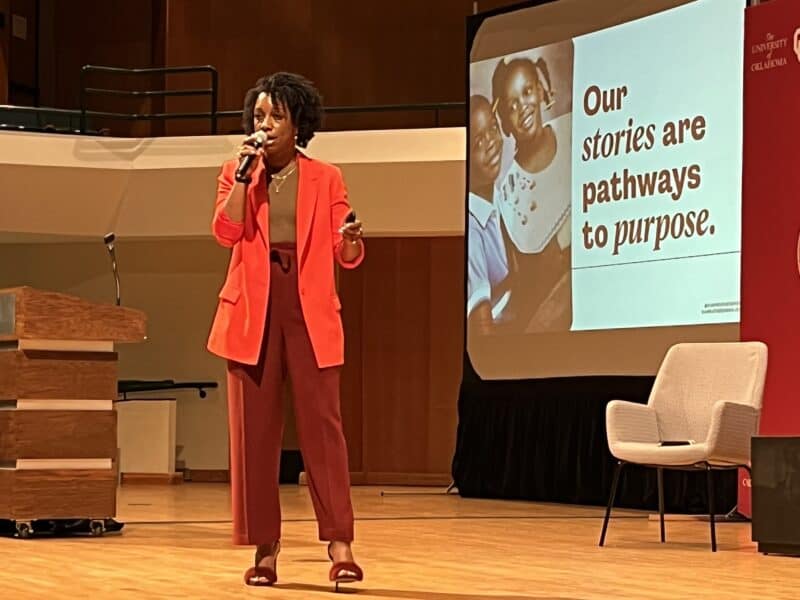
Kia Weatherspoon, President, Determined by Design, shared how her personal stories were her pathway to purpose.
Purpose Driven Path to Design Equity
Kia Weatherspoon, President, Determined by Design (interior design)
Kia shared how she came to work in interior design. Visiting her brother in prison, she found walking into the building and the entire environment to be dehumanizing. Later she served in the Air National Guard with three tours in Iraq. She improvised a space by hanging up sheets so she could feel safe dealing with the overwhelming emotions of war.
Those experiences–war and prison–brought her to understand how space hurts or heals people.
She works on affordable housing and other projects that normally don’t receive much if any purposeful interior design.
Her first project was for a domestic violence shelter for women. While some initially told her they didn’t need a well designed space because they had other needs to spend that money on, Kia persisted. Once it was finished, one of the women said to her, “When I walked into this space, I realized that change was possible for me.”
“The people who most need design don’t know they don’t have it, and they have no advocate,” Kia said.
- That resonated with me as rural people have little access to the kind of design that can make a difference in their lives, don’t know they don’t have it, and they have no advocate.
Kia said she digs deeply into the stories of the place starting with the land and the Indigenous people of the area. As she moves through the history of the place, she continues to collect stories and images to incorporate into her designs. She uses the phrase “Conjuring ripe heirlooms” to describe what they are creating.
Because these projects usually benefit people with low incomes, sometimes others will push back on her design choices. “You’re making it too nice for these people.” Kia said she sees it differently, asking herself “Is this good enough for my grandmother, my brother, my friend?”
“The spaces that we create today will affect four generations of people,” Kia said.
- That really hit me, as I don’t remember any design discussions in small towns that said out loud that these decisions will affect four generations (or more) in our community.
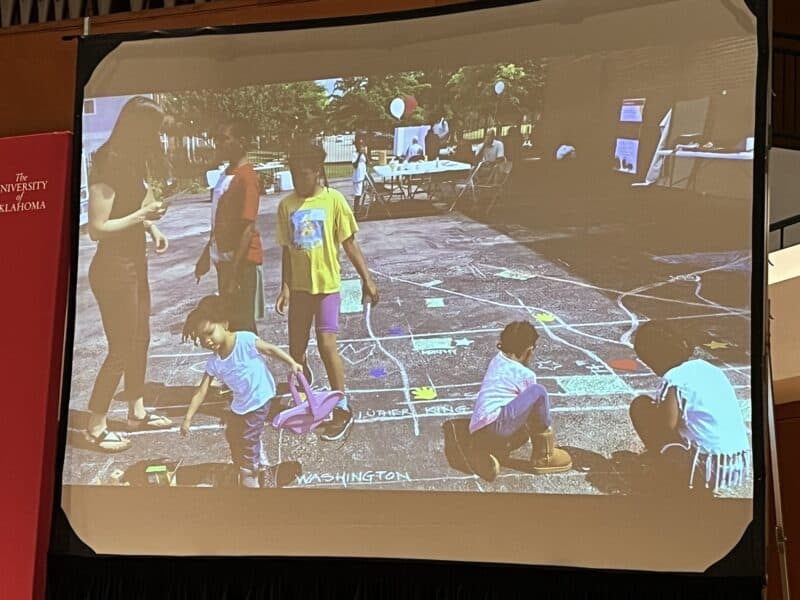
Mukul Malhotra showed this slide of children interacting with a map of their community. “Steal ideas from kids,” he said.
Neighborhoods and Streets for Exchange and Connection
Mukul Malhotra, Principal and Director of Urban Design, MIG, Inc.
Mukul shared stories of street designs and how they affect people and neighborhoods.
Mukul said when you design a street, don’t design it in a room. Go to the street and the people. Get design ideas from kids; they have great ideas. And test your designs before implementing them.
“As designers we don’t always know what will work,” Mukul said.
“But it looks great on a map!” is no excuse for a poor design. Spend more time on building crosswalks than sidewalks. Curbs prevent flexible uses, he said.
One of the most excluded activities is play, he said. The other is mobility.
Mukul also talked about placekeeping, not just placemaking. Many vibrant urban neighborhoods have been lost to big infrastructure projects.
- There is definitely a parallel to our small towns and what we’ve lost due to disinvestment and lack of investment through the decades.
People create places, Mukul said. Give us a reason to be there.
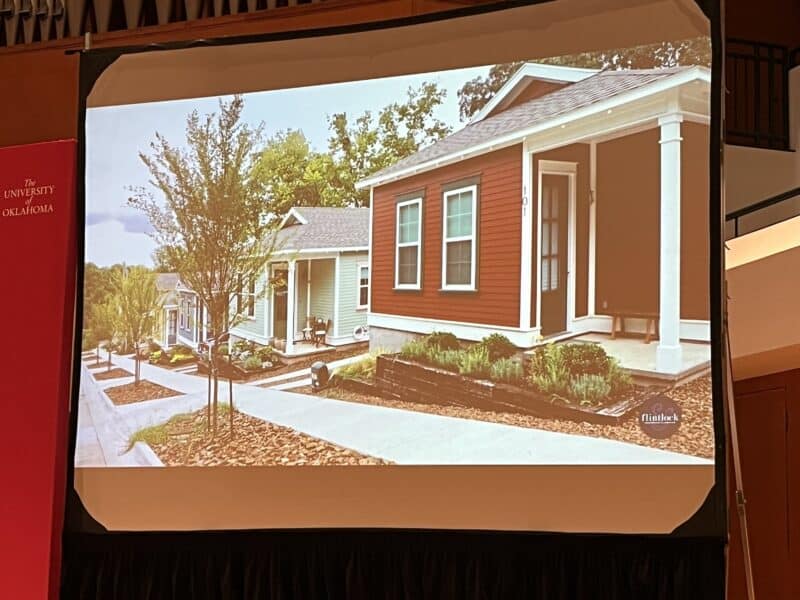
These one bedroom cottages had to be carefully created to meet code, comply with mortgage rules, and fit into the site.
The Power of Cute: Lovable Incremental Community Development
Allison Thurmond Quinlan, Principal of Flintlock Labs, Fayetteville, Arkansas
The product the market needs is not the product the market knows how to produce, Allison said.
As household size shrinks, we need twice as many housing units to house the same population.
1 and 2 person households are the majority of all households, but that’s not the kind of houses we have. There are more 5 bedroom houses in America than 1 bedroom, she said.
Alison said they build small and loveable housing. Loveable efficiency, they call it. Build for people.
Make things cute AF, she said.
Allison shared her design for South Street Cottages and other small scale housing.
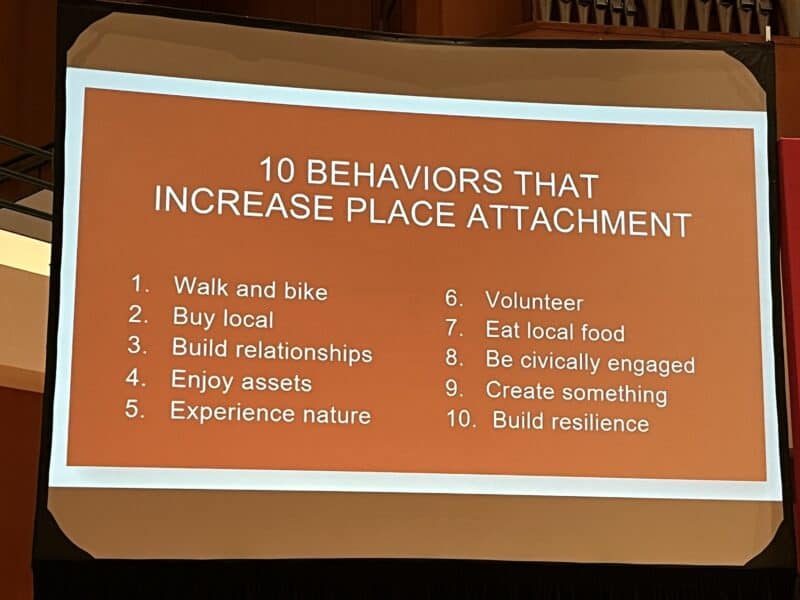
Melody Warnick says you can increase how attached you feel to your place through simple experiences.
The Daily Practice of Loving Where You Live: How to Create Joy in Our Imperfect Places
Melody Warnick, Author, This is Where You Belong and If You Could Live Anywhere
Rooted people feel like they want to be where they live, Melody said. That feeling changes, and it takes about 5 years from arriving in a place for your attachment to peak.
Being excluded is interpreted as physical pain by the brain, Melody said.
Even if you’re a 10 on place attachment, someone else in town is a 1 or 0, she said.
Walking and biking gives you mental maps and that gives you a sense of ownership and involvement, Melody said.
Anyone can choose to do things that will help them feel more attached to their place and a stronger sense of belonging in their community, Melody said.
Just getting a lot of people in the same place makes a community feel vibrant. Make love visible in your community, she said.
I’ve followed Melody online for many years. I highly recommend both of her books.
Our Greatest Source of Joy and Happiness are the Vibrant, Walkable Public Spaces Around Us
Arti Harchekar, Founding Principal, JoyfulUrbanist.com
Arti said we naturally tend to react more to negative experiences. If we can create consistent happiness stimulation, we can rewire the brain to better experience the positive.
Sharing her own struggle with depression, she said third places give flexible levels of interaction to people. Even a quick exchange of “hi” and “thanks” at the local store can be supportive when it’s needed.
Order reduces our anxiety, and an organized cityscape or townscape counts. In a vibrant downtown street, you are being hugged by the environment, she said.
Where the building meets the street, what does it gift to the community? For example, a porch is a gift of being available to connect.
- I thought this was a great way to look at buildings. What gifts do they give us?
Background buildings are the givers of the local environment. They give to the whole community, Arti said. Landmark buildings stand out. You can’t have every building be a landmark or they lose what makes them special.
Put the pedestrian in the middle of the space, and they set the pace for the area.
What percentage of your town’s built environment is the streets? That’s a great question from Arti for cities, but also for small towns. We have a lot of our community in streets.
And still we love this place
Ronald H. Frantz is Director of Small Town Studios at OU Institute for Quality Communities. His previous work at Oklahoma Main Street introduced him to small towns all across the state. While introducing the panel discussion with Melody and Arti, Ron listed off a number of horrible yet true quality of life stats for Oklahoma.
“We’re last in quality of life,” Ron said.
Cheryl Lawson of Tulsa turned to me and added, “and still we love this place.”
- There’s a lot to think about in this exchange. We can acknowledge that our quality of life isn’t great. We don’t benefit from great design, and we don’t even know we don’t have it, as Kia said. Our small towns struggle with huge challenges, and we have many challenges in common with some of our most urban neighborhoods.
- And still we love this place. We have connection, as Melody said. We have families and networks and history here. We’ve learned ways to adapt to where we are. We work to make things better, even as we face our shortcomings.
Watch for more from Cheryl Lawson, coming up.
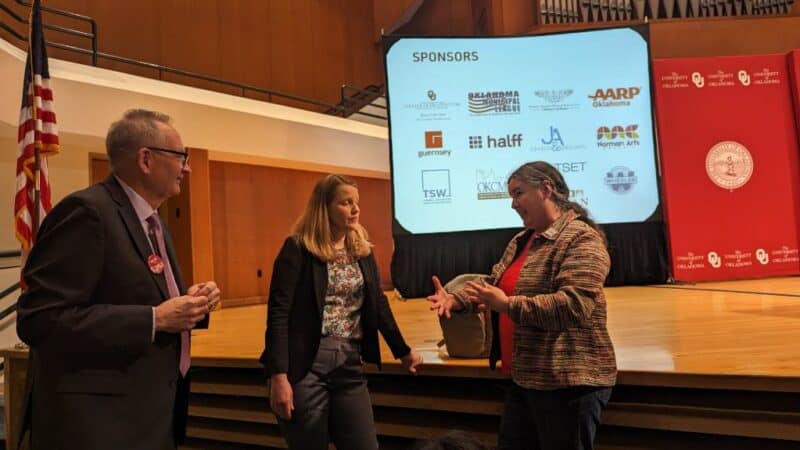
Ron Franz, Melody Warnick and Becky McCray talk during a break at the 2023 OU Placemaking Conference Institute for Quality Communities. Photo by Cheryl Lawson.
Leadership in Place Management
Jane Jenkins, Principal, Jane Jenkins Resources, Downtown OKC (Oklahoma City)
Former Main Street director from Wagoner, Oklahoma
While Jane mostly talked about city ideas that weren’t easy to adapt, she shared a couple of great small town one liners:
You are going to make mistakes.
Money is not the issue.
She also shared a 3 minute video based on the book “The Secret Life of Small Urban Spaces” by William H. Whyte. She called it the best 3 minute placemaking lesson available.
- While it skews urban, we can steal a lot of this for rural communities.
Big Ideas: Transforming Fort Worth’s Central City
Fernando Costa, Assistant City Manager, City of Fort Worth
This was another session that was hard for small towns to relate to.
One great point was that any community can design public spaces to encourage healthy behavior. Over 70% of health is determined by lifestyle and environment.
One suggestion that I’m sure he didn’t mean to be as amusing as I found it, was to convert auto oriented urban commercial corridors into walkable villages. So any of your wide two-lanes-each-direction sprawly areas dominated by drive-throughs and chains could be more like a walkable downtown. He even went so far as to use the words “walkable villages.” Here’s the funny part: The only three things you need are money, incentives (more money), and zoning.
- Let me know if your small town can round up money, more money and zoning for anything.
National Trends for Cities and Mayors
Trinity Simons Wagner, Executive Director, Mayors’ Institute on City Design
Again, not a great small town idea session. Even then, there were two points from Trinity that I latched onto.
Vacant buildings, especially formerly significant ones, are reminders of loss.
- That statement really hurts for small towns and rural communities, full of vacant buildings and memories.
If you aren’t building WITH your community, you aren’t building FOR your community.
Trinity said that (If you’re not building WITH, you’re not building FOR) as almost a throwaway line as she rushed through the end of her talk. It could almost sum up the conference, as it was a recurring theme from nearly every presenter.
- I know that doesn’t mean we’ll see this attitude in practice from design professionals serving rural communities very often, but I take my encouragement where I can get it.
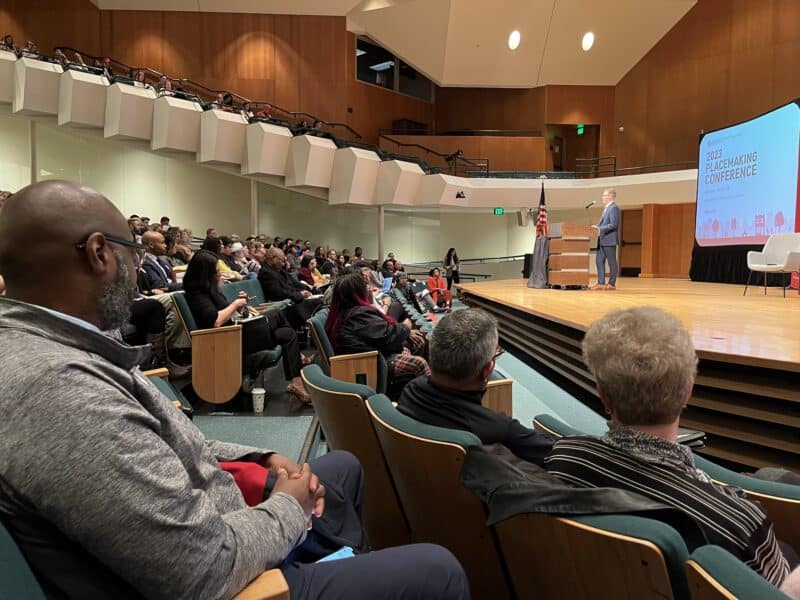
OU IQC Director Shane Hampton opened the conference. Dwayne Bright from Kansas City, Kansas, is seated to the left.
Rural + Urban connections
I was sitting next to (and really surrounded by) a group from Kansas City, Kansas, who attended to learn more about housing and ideas they could use in their urban neighborhoods. Dwayne Bright is a Fuse Executive Fellow working there. We had some interesting discussions about how rural communities and urban neighborhoods are similar. Both have lost housing and much more over the decades, and many similar ideas will work in both types of communities.
This was not new to me, from conversations with Cheryl Lawson and others about their communities and with you about your rural ones.
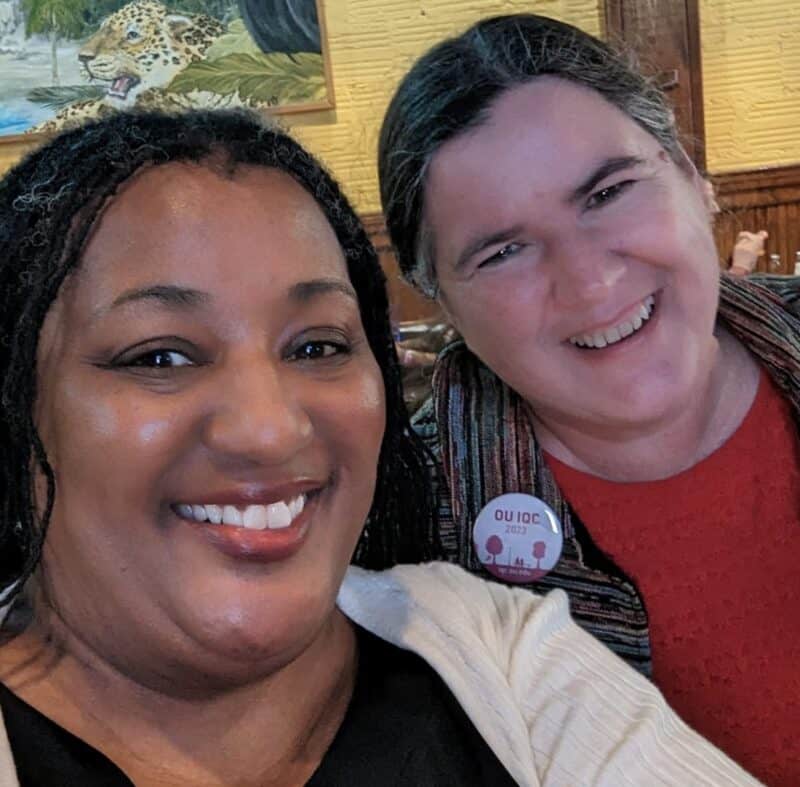
Cheryl Lawson of Tulsa attended the Placemaking Conference after seeing my tweet about it.
Cheryl Lawson is a longtime online community leader and offline placemaker in Tulsa. She created and led the #SMTulsa Conference for 10 years, and I was honored to be involved each year. Cheryl has welcomed me into the SMTulsa family, where I have learned a great deal about community building and social media.
Through SMTulsa friends like Cheryl and Carlo Moreno, I’ve learned a lot about the terrible history of the Tulsa Race Massacre, as well as Tulsa’s Greenwood District past and present, the North Tulsa neighborhood of today, and Oklahoma’s historic All Black Towns. I’m no expert, but this knowledge has definitely broadened my perspectives.
Read Cheryl’s event report at Medium.
Subscribe to SmallBizSurvival.com
